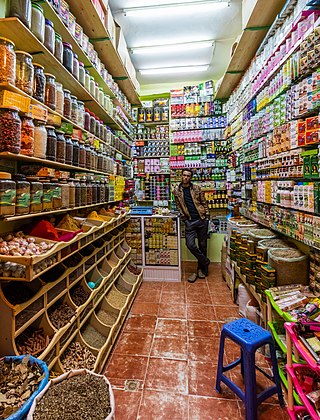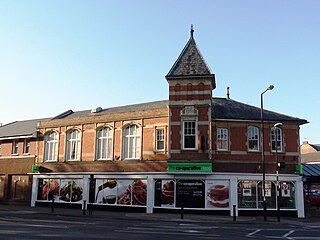Related Research Articles

Canadian Tire Corporation, Limited is a Canadian retail company which operates in the automotive, hardware, sports, leisure and housewares sectors. Its Canadian operations include: Canadian Tire, Mark's, FGL Sports, PartSource, and the Canadian operations of Party City. Canadian Tire acquired the Norwegian clothing and textile company Helly Hansen from the Ontario Teachers' Pension Plan in 2018.

Retail is the sale of goods and services to consumers, in contrast to wholesaling, which is sale to business or institutional customers. A retailer purchases goods in large quantities from manufacturers, directly or through a wholesaler, and then sells in smaller quantities to consumers for a profit. Retailers are the final link in the supply chain from producers to consumers.
Sales promotion is one of the elements of the promotional mix. The primary elements in the promotional mix are advertising, personal selling, direct marketing and publicity/public relations. Sales promotion uses both media and non-media marketing communications for a pre-determined, limited time to increase consumer demand, stimulate market demand or improve product availability. Examples include contests, coupons, freebies, loss leaders, point of purchase displays, premiums, prizes, product samples, and rebates.
The True Value Company is an American wholesaler.

Hardware stores, sometimes known as DIY stores, sell household hardware for home improvement including: fasteners, building materials, hand tools, power tools, keys, locks, hinges, chains, plumbing supplies, electrical supplies, cleaning products, housewares, tools, utensils, paint, and lawn and garden products directly to consumers for use at home or for business. Many hardware stores have specialty departments unique to its region or its owner's interests. These departments include hunting and fishing supplies, plants and nursery products, marine and boating supplies, pet food and supplies, farm and ranch supplies including animal feed, swimming pool chemicals, homebrewing supplies and canning supplies. The five largest hardware retailers in the world are The Home Depot, Lowe's, Kingfisher of the United Kingdom, Obi of Germany, and Leroy Merlin of France.

A big-box store is a physically large retail establishment, usually part of a chain of stores. The term sometimes also refers, by extension, to the company that operates the store. The term "big-box" references the typical appearance of buildings occupied by such stores.

Wesfarmers Limited is an Australian conglomerate, headquartered in Perth, Western Australia. It has interests predominantly in Australia and New Zealand, operating in retail, chemical, fertiliser, industrial and safety products. With revenue of A$43.5 billion in the 2023 financial year, it is one of Australia's largest companies by revenue. Wesfarmers is also one of the largest private employers in Australia, with approximately 107,000 employees.
Retail media is marketing to consumers at or near their point of purchase, or point of choice between competing brands or products. Common techniques include in-store advertising, online advertising, sampling, loyalty cards and coupons or vouchers.

A consumers' co-operative is an enterprise owned by consumers and managed democratically and that aims at fulfilling the needs and aspirations of its members. Such co-operatives operate within the market system, independently of the state, as a form of mutual aid, oriented toward service rather than pecuniary profit. Many cooperatives, however, do have a degree of profit orientation. Just like other corporations, some cooperatives issue dividends to owners based on a share of total net profit or earnings ; or based on a percentage of the total amount of purchases made by the owner. Regardless of whether they issue a dividend or not, most consumers’ cooperatives will offer owners discounts and preferential access to goods and services.

Once the strategic plan is in place, retail managers turn to the more managerial aspects of planning. A retail mix is devised for the purpose of coordinating day-to-day tactical decisions. The retail marketing mix typically consists of six broad decision layers including product decisions, place decisions, promotion, price, personnel and presentation. The retail mix is loosely based on the marketing mix, but has been expanded and modified in line with the unique needs of the retail context. A number of scholars have argued for an expanded marketing, mix with the inclusion of two new Ps, namely, Personnel and Presentation since these contribute to the customer's unique retail experience and are the principal basis for retail differentiation. Yet other scholars argue that the Retail Format should be included. The modified retail marketing mix that is most commonly cited in textbooks is often called the 6 Ps of retailing.

Visual merchandising is the practice in the retail industry of optimizing the presentation of products and services to better highlight their features and benefits. The purpose of such visual merchandising is to attract, engage, and motivate the customer towards making a purchase.
A marketing channel consists of the people, organizations, and activities necessary to transfer the ownership of goods from the point of production to the point of consumption. It is the way products get to the end-user, the consumer; and is also known as a distribution channel. A marketing channel is a useful tool for management, and is crucial to creating an effective and well-planned marketing strategy.

In the retail industry, a buyer is an individual who selects what items are stocked and their key responsibility is dealing with all the products that come into the store. Buyers usually work closely with designers and their designated sales representatives and attend trade fairs, wholesale showrooms and fashion shows to observe trends. They are employed by large department stores, chain stores or smaller boutiques. For smaller independent stores, a buyer may participate in sales as well as promotion, whereas in a major fashion store there may be different levels of seniority such as trainee buyers, assistant buyers, senior buyers and buying managers, and buying directors. Decisions about what to stock can greatly affect fashion businesses.
Fashion merchandising can be defined as the planning and promotion of sales by presenting a product to the right market at the proper time, by carrying out organized, skillful advertising, using attractive displays, etc. Merchandising, within fashion retail, refers specifically to the stock planning, management, and control process. Fashion Merchandising is a job that is done world- wide. This position requires well-developed quantitative skills, and natural ability to discover trends, meaning relationships and interrelationships among standard sales and stock figures. In the fashion industry, there are two different merchandising teams: the visual merchandising team, and the fashion merchandising team.

A bicycle cooperative can take the many forms of the cooperative model. These often include co-ops composed of businesses to achieve economies of scale, co-ops managed by those who work at the business, and bicycle co-ops owned and managed by the cyclists that use their services. To date, many bicycle co-ops have taken the form of community bike shops and cooperatives organized to give the local bike shop national scale and buying power.
Mitre 10 is a New Zealand chain of home improvement stores established in June 1974. The company sells a range of household hardware, building supplies, heaters, air conditioners, garden products, barbeques and camping gear.
Wholesale fashion distribution refers to the global market of bulk clothing sales, in which producers, wholesalers and sellers are involved in a commercial, business-to-business process.
Sycamore Partners is an American private equity firm based in New York specializing in retail and consumer investments. The firm has approximately $10 billion in aggregate committed capital.
The retail format influences the consumer's store choice and addresses the consumer's expectations. At its most basic level, a retail format is a simple marketplace, that is; a location where goods and services are exchanged. In some parts of the world, the retail sector is still dominated by small family-run stores, but large retail chains are increasingly dominating the sector, because they can exert considerable buying power and pass on the savings in the form of lower prices. Many of these large retail chains also produce their own private labels which compete alongside manufacturer brands. Considerable consolidation of retail stores has changed the retail landscape, transferring power away from wholesalers and into the hands of the large retail chains.
References
- 1 2 3 Baron, Marie-Laure (September 2007). "Defining the Frontiers of the Firm through Property Rights Allocation: The Case of the French Retailer Cooperative Leclerc". Review of Social Economy. 65 (3): 293–317. JSTOR 29770417.
- 1 2 Hibbard, Jonathan. "Merchandising Conglomerates". Encyclopædia Britannica.
- 1 2 Bogardus, Emory (1964). Principles of Cooperation. Chicago, Illinois: The Cooperative League of the U.S.A. pp. 20–24.